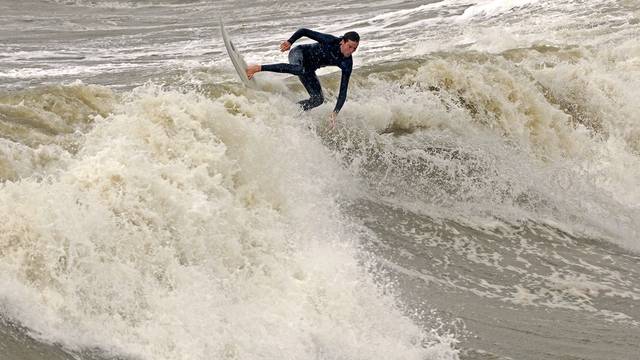Belgium
Country/State Data
Breaks
7
Coastline
66 KM
Cost of living
Capital
Brussels
Security
Health
Positives
- Multiple jetty spots for wind protection
- North Sea NW-N swells
- Good waves for learners
- Easy access
Negatives
- Small, messy waves
- Always onshore
- Flat summers
- North Sea pollution issues
Where to surf in Belgium
The North Sea coastline of Belgium is not the most alluring of European surf destinations, yet more and more surfers are hitting the line-up every year. Belgium generally receives less swell than the Netherlands and the lack of depth offshore robs the swell of some power. Perfectly situated to pick up the NW-N swells created by low pressure systems off Norway and also able to catch SW windswell the key is whether the wind will co-operate and switch offshore after producing a swell. There are many jetties to find some protection behind but surfing the regular onshore days is all part of the experience. A strong swell should see consistent breaks like Blankenberge get up to shoulder or even head high. Summer is usually flat so aim for early winter before water temps drop to a chilly 5ºC (41ºF) in February and snowy sand is always a possibility.
Surf spots in Belgium
Research the 7 surf breaks in Belgium and discover what spots suit the current conditions.

Blankenberge
The large pier provides stable sandbanks and cuts the howling onshores leaving some decent rights on...
Break lowdown
We’ve collated the wave data giving you a unique insight into the 7 breaks in Belgium.
When to go
Surf and weather statistics to help plan your surf trip to Belgium
- jan
- feb
- mar
- apr
- may
- jun
- jul
- aug
- sep
- oct
- nov
- dec
Travel Information
General
- Tourists
- 9,119,000
- Population
- 11,589,623
- Tourist Info
- Tourist Info
Security
Health
Money
- Currency
- EUR
- Exchange rate
- $1USD = 0.87 EURLast updated: Sat, 02 Aug 2025
Cost of living
Communication
- Dialing in
- +32
- Dialing out
- 00
- Emergencies
- 112
- Language
- Dutch, French, German
Electricity
- Plug Type
- e
Visas
The Netherlands and Belgium are signed up to the Schengen and Benelux agreements. No visa required for citizens of most EU countries, USA, Australia, Canada and New Zealand. All others, including South Africans and those planning to stay more than three months, must obtain a visa from the relevant consulate in their home country.
Getting There
Brussels Airport (BRU) is the international hub. Brussels Airlines are the national carrier together with British Airways and Easyjetfrom the UK. Delta and United from the US.
Ferries ply the North Sea from the UK. Dunkirk with DFDS or Hull to Zeebrugge with P&O are the most direct routes but Calais is not too far to drive.
Belgium is linked by Thalys, TGV and Eurostar and ICE networks for continental wide rail links. Eurolines and Flixbus operate international coaches. Eurotunnel links the UK to mainland Europe at Calais, from where it takes 1h to get to Ostend. The limits are 50/90/120km/h for town, open road and motorway respectively.
Getting Around
No internal flights.
Belgian trains have ‘cheap-day-at-the-seaside’ tickets and sports equipment is carried for free. First rate roads follow the coast.
Activities
Surf Culture
History
The Stormrider Passport
Get your Stormrider Passport to explore 5000 surf spots for as little as £1.25 a month.
What’s in it for you?
- 01.
5,000 DETAILED BREAK REPORTS
Access to 5,000 detailed surf spot descriptions with ability to save spots for offline access.
- 02.
10 STORMRIDER ICONS FOR EVERY SPOT
Compare our iconic, easily recognisable symbols, highlighting 10 crucial factors for every surf break.
- 03.
UNIQUE STORMRIDER FILTERS
Personalise your search by matching your skill level, travel plans, and seasonal preferences to discover your perfect waves.
- 04.
WINDY FORECAST FOR EVERY BREAK
Get the latest surf conditions from our forecast partners at Windy, plus webcams and forecasting links.
- 05.
COMPARE REGIONAL SURF SPOT DATA
Compare regional break data and statistics to quickly discover your ideal surf destinations.
- 06.
CREATE YOUR PERSONAL WORLD SURF MAP
Easily build a map of your worldwide surf travel adventures, or create a bucket list of future destinations.

We've got more in the pipeline
Signing up not only gives you access to the World’s best surf information, it allows us to create even more amazing features in the future.
